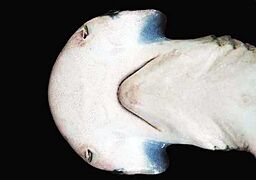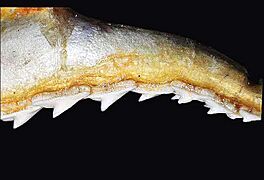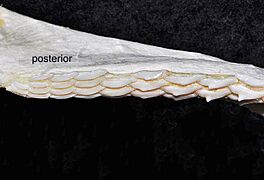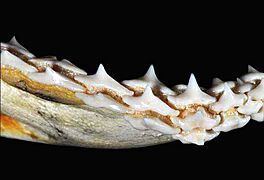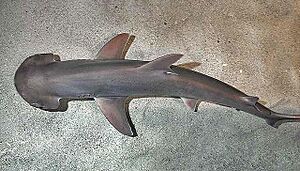Bonnethead facts for kids
The bonnethead shark (also known as a bonnet shark or shovelhead) is a small type of hammerhead shark. It lives in warm coastal waters, especially in the North Atlantic Ocean and the Gulf of Mexico. This unique shark is special because it's the only shark known to have different head shapes for males and females. It's also the only shark known to eat both meat and plants, making it an omnivorous shark!
Quick facts for kids Bonnethead shark |
|
|---|---|
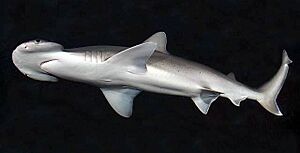 |
|
 |
|
| Conservation status | |
| Scientific classification | |
| Genus: |
Sphyrna
|
| Species: |
tiburo
|
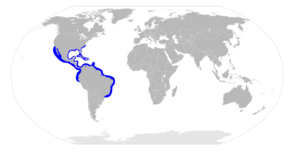 |
|
| Range of the bonnethead shark | |
Contents
What Does a Bonnethead Shark Look Like?
The bonnethead shark has a wide, smooth, and spade-shaped head. Its "hammer" (called a cephalofoil) is the smallest among all hammerhead sharks. Its body is usually grey-brown on top and lighter underneath.
Most bonnethead sharks are about 80–90 cm (2.6–3.0 ft) (around 2.5 to 3 feet) long. The biggest ones can grow up to 150 cm (4.9 ft) (about 5 feet) long. The name Sphyrna comes from a Greek word meaning "hammer," which describes its head shape.
Do Male and Female Bonnetheads Look Different?
Yes, bonnethead sharks are the only sharks where males and females have different head shapes! Adult female bonnetheads have a rounder head. Males, however, develop a noticeable bump on the front edge of their "hammer" when they become adults. This bump grows at the same time as other parts that show they are ready to mate.
How Do Bonnetheads Swim?
Most fish use their pectoral fins (the ones on their sides) to control how they move up and down, side to side, and roll. Many hammerhead sharks use their large "hammers" to help them swim straight and control their pitch.
Bonnethead sharks have a smaller "hammer," so they rely more on their large pectoral fins for swimming. They are the only hammerhead species that actively use these fins to help them move through the water.
Where Do Bonnethead Sharks Live?
Bonnethead sharks live in warm waters along both sides of the American coast. In the Atlantic Ocean, you can find them from New England down to the Gulf of Mexico and Brazil. In the Pacific Ocean, they live from southern California to northern Peru.
During summer, they are common near the coasts of the Carolinas and Georgia. In spring, summer, and fall, they are found off Florida and in the Gulf of Mexico. In winter, they move closer to the equator where the water stays warmer.
They like shallow areas like estuaries and bays, often over seagrass, mud, or sandy bottoms. While still common in some areas, their numbers have dropped in the Caribbean Sea and parts of the South Atlantic and Pacific.
What Do Bonnethead Sharks Do?
How Do They Behave?
Bonnethead sharks are active sharks that usually swim in small groups of 5 to 15. Sometimes, very large groups of hundreds or even thousands have been seen! They are always moving to follow changes in water temperature and to breathe. Hammerhead sharks are not very buoyant (they don't float well), so bonnetheads must keep swimming to avoid sinking.
What Do Bonnethead Sharks Eat?
These sharks mainly eat crustaceans, especially blue crabs. They also eat shrimp, mollusks, and small fish. When hunting, they swim close to the seafloor, swinging their heads from side to side like a metal detector. They are looking for tiny electrical signals that crabs and other creatures make while hiding in the sand.
When a bonnethead finds something, it quickly turns and bites into the sand. If it catches a crab, it uses its teeth to crush the crab's shell. Then, it uses suction to swallow its meal. Bonnethead sharks have different kinds of teeth: small, sharp teeth in the front for grabbing soft prey, and flat, wide molar-like teeth in the back for crushing hard shells.
Interestingly, bonnetheads also eat a lot of seagrass. It can make up more than 60% of what's in their stomachs! This makes them the only known omnivorous shark species. Scientists think they might eat seagrass to help protect their stomachs from the spiny shells of the crabs they eat. A study in 2018 showed that they can actually digest seagrass quite well, getting nutrients from it.
How Do Bonnethead Sharks Have Babies?
Bonnethead sharks are viviparous, which means they give birth to live young, just like mammals. Female bonnetheads are ready to have babies when they are about 32 inches (81 cm) (2.6 feet) long. Males are ready when they are around 24 inches (61 cm) (2 feet) long.
They have one of the shortest pregnancy periods among sharks, lasting only about 4.5 to 5 months. Four to twelve baby sharks, called pups, are born in late summer and early fall. Each pup is about 12 to 13 in (300 to 330 mm) (around 1 foot) long when born.
In one amazing case, a female bonnethead shark at the Henry Doorly Zoo in Nebraska had a pup without a male shark. This is called parthenogenesis, or "virgin birth." DNA tests showed the pup was a perfect match to its mother.
Are Bonnethead Sharks Endangered?
The bonnethead shark was once considered a species of "least concern" by the IUCN (International Union for Conservation of Nature). They are caught a lot by both commercial and recreational fishermen. In the Eastern US, they make up a large part of all small sharks caught. They are still quite common there, as well as in the Atlantic Coasts of the Bahamas and Mexico.
However, their numbers have dropped a lot in the Caribbean Sea and along the Atlantic Coast of Central America. They have almost disappeared from most of their South Atlantic and Pacific range. Because of these declines, their status was changed to "Endangered" in 2020. Since October 2021, the IUCN has classified them as "Largely Depleted."
Images for kids



